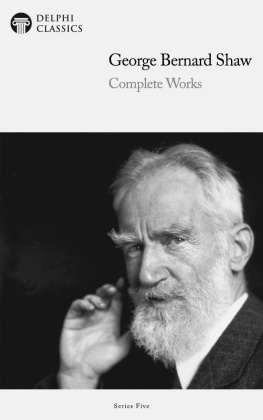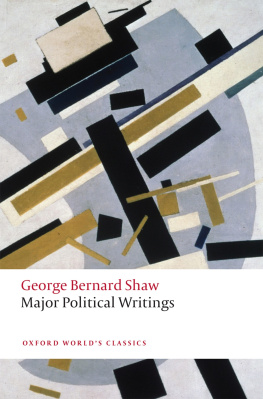
Shaw and Feminisms
The Florida Bernard Shaw Series

UNIVERSITY PRESS OF FLORIDA
Florida A&M University, Tallahassee
Florida Atlantic University, Boca Raton
Florida Gulf Coast University, Ft. Myers
Florida International University, Miami
Florida State University, Tallahassee
New College of Florida, Sarasota
University of Central Florida, Orlando
University of Florida, Gainesville
University of North Florida, Jacksonville
University of South Florida, Tampa
University of West Florida, Pensacola
Shaw and Feminisms

On Stage and Off
Edited by D. A. Hadfield and Jean Reynolds
Foreword by Rodelle Weintraub
University Press of Florida
Gainesville Tallahassee Tampa Boca Raton
Pensacola Orlando Miami Jacksonville Ft. Myers Sarasota
Copyright 2013 by D. A. Hadfield and Jean Reynolds
All rights reserved.
Printed in the United States of America. This book is printed on Glatfelter Natures Book, a paper certified under the standards of the Forestry Stewardship Council (FSC). It is a recycled stock that contains 30 percent post-consumer waste and is acid-free.
This book may be available in an electronic edition.
18 17 16 15 14 13 6 5 4 3 2 1
A record of cataloging-in-publication data is available from the Library of Congress.
ISBN 978-0-8130-4243-5
The University Press of Florida is the scholarly publishing agency for the State University System of Florida, comprising Florida A&M University, Florida Atlantic University, Florida Gulf Coast University, Florida International University, Florida State University, New College of Florida, University of Central Florida, University of Florida, University of North Florida, University of South Florida, and University of West Florida.
University Press of Florida
15 Northwest 15th Street
Gainesville, FL 32611-2079
http://www.upf.com

Funding to assist in the publication of this book was generously provided by the David and Rachel Howie Foundation.
To LWC
Mentor, colleague, friend
Contents
Rodelle Weintraub

Tracy J. R. Collins
Lawrence Switzky
Ann Wilson
Brad Kent

Leonard W. Conolly
D. A. Hadfield
Margaret D. Stetz
Virginia Costello

Kay Li
John M. McInerney
Interview and editing by D. A. Hadfield
Michel Pharand
Foreword
In 1977 when Fabian Feminist: Bernard Shaw and Woman was published, womens studies was in its infancy. Coincidentally, the National Womens Studies Association was founded in 1977. Although the first program in womens studies was begun in 1970 at San Diego State College (now San Diego State University) of California, it was not until the 1980s that colleges and universities established departments of womens studies that were not merely a program in some other department such as American studies. A generation and a half of women has matured since those beginnings.
In 1981, Michiko Kakutani in her New York Times article G.B.S. and the Women in His Life and Art (27 September 1981) complained that Shaw had been adopted as a kind of father figure by certain proponents of womens liberation, singling out Rodelle Weintraub and Fabian Feminist for contributing to that idealization. Rather than finding Shaw to be a feminist father figure, Kakutani accused him of employing the misogynist vocabulary of Schopenhauer and Nietzsche in his plays, describing woman as a predatory animal intent on imprisoning her male prey. What woman did she mean besides Ann Whitefield in Man and Superman? And Ann was hardly one of Shaws New Women. Although Shaw claimed to have stood up for the intellectual capacity of women, Kakutani wrote, he reserved creativity for the male. (See one of those predatory women) in Misalliance, and Eliza Doolittle in My Fair Lady, the musical adaptation of Pygmalion.
The response to Kakutanis viewswhether challenge or confirmationhas been long overdue, despite a number of studies of Shaws relationships with women and involvement in womens issues. Margot Peterss Shaw and the Actresses (1981) examines his relationships with actresses, and J. Ellen Gainors Shaws Daughters: Dramatic and Narrative Constructions of Gender (1992) focuses on analyses of Shaws plays. In Shaws Life: A Feminist in Spite of Himself and Bernard Shaw: The Ascent of the Superman, Sally Peters discusses Shaws views on women in a number of contexts, including his family, his marriage, his friendships with women, the women who populate his plays, and his advocacy for womens suffrage. A. M. Gibbs, in his Bernard Shaw: A Life (2005), provides an extensive discussion of Shaws relations with women and their influence on his prose fiction and dramatic writings, and Gibbs includes an entire chapter concerned with Shaws connections with feminism, on- and offstage.
But no book has focused solely on Shaws position in historical feminism. Opening this volume and breaking new ground, we find an article on athleticism in Shaws New Women. Following are discussions about his curious employment of cruelty and pain on and off the stage, another look at the mother-daughter relationship of Kitty and Vivie Warren, the echoes of Ibsens A Dolls House in the plays, and until now the overlooked Irish women, one of whom is named Nora (as in Ibsen), in John Bulls Other Island.
Did Shaw practice what he preached? The essays in , Shaws Relationships with Women, which focus on Shaw and actual New Women, not stage presentations, open a window into his discomfort with the real thing. How supportive of these real-life New Women was he? Did he encourage them to speak and to act for themselves? Even those of us well acquainted with Shaviana will be surprised by the article about Shaw and the anarchist Emma Goldman.
The final section of Shaw and Feminisms examines some aspects of Shavian feminism in the larger world, from transnational Chinese feminism to American ambivalence toward women such as Hillary Clinton as powerful public figures. The volume ends with an interview with Jackie Maxwell, artistic director of the Shaw Festival in Niagara-on-the-Lake, Ontario, Canada. The festival, begun in 1962 with a production of Candida, Shaws own Dolls House, celebrated its half century in the 2011 season by performing it again. Other theaters outside of England that perform Shaw regularly are the New York Gingold Theatrical Groups Project Shaw, the Washington D.C. Stage Guild, and ShawChicago.
Michel Pharands bibliography of writings on Shaw and women brings us up to date on the publications on the topic of Shaw and woman.
Next page












